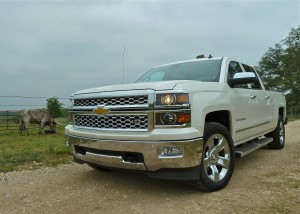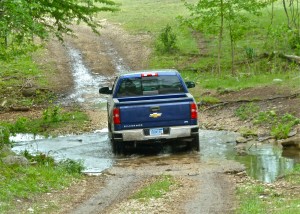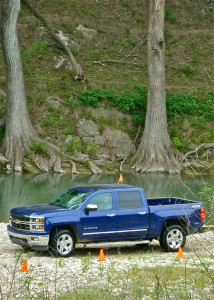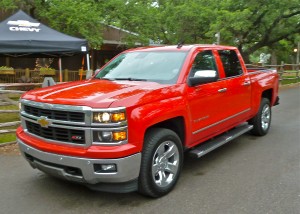New Silverado catches foes with high-tech features
By John Gilbert
SAN ANTONIO, TEXAS — The new Chevy pickup is finally here.
Recent ad campaigns have pushed the “new” 2013 Silverado and its discount pricing, but the realilty is that the 2014 model just being introduced is the first new-generation Silverado in seven years. It will send loyal Chevy fans into celebration, although others may ask the challenging question: Is the 2014 Chevrolet Silverado new enough?
“It’s all-new from hood to hitch,” said Silverado product manager Carl Hillenbrand, sounding like he had just made up a new sales motto for the dozens of new Silverados drove, towed, hauled, and off-roaded their way through the media introduction in the rolling hills west of San Antonio.
Down below our vantage point, a pair of shiny new Silverados were parked, with the biggest Crew Cab model adjacent to a middle-sized extended-cab model, which will called, from now on, the Double Cab. It was quickly pointed out to me that the extended-cab model I was admiring was a current 2013, not the new 2014. Oops! My mistake.
The differences in appearance are slight enough that the change might be mistaken for a different model rather a change from old to new trucks. All the new ones have squarish “shoulder” bulges, and the new and enlarged grille. Less noticeable is the slightly wider size, and the windshield, which has a flatter slope by an indecipherable 1 degree. The significant changes are under the skin, and inside the cabin.
Seven years is a long time in the auto business. A company can go bankrupt, catch a big government loan, reorganize itself, and get back on the road to profitability in that much time. Seven years also can encompass more than one and almost two generations of new vehicles in a model line, and falling behind in something as competitive as the full-size, half-ton pickup market can be risky, with all the fabulous new technology competitors have been installing, model year after year.
It has been seven years since Chevrolet brought out its last new Silverado, for the 2007 model year, and the hefty inventories of remaining 2013 trucks might indicate how strong the more recently renewed competitors from arch-rival Ford, the reinvigorated Ram 1500, the 2013 North American Truck of the Year, as well as the highly competent Toyota Tundra.
But the late-to-the-party Silverado probably won’t suffer a bit, because of something called brand loyalty. “Pickup truck buyers are the most brand-loyal of any customers,” said Lloyd Biermann, Chevrolet’s marketing manager for the Silverado, as we sat on the elongated deck of the Knibbe Ranch, an hour west of San Antonio. “There aren’t many conquests between Chevy and Ford pickup buyers, although that’s not as certain at the high end. If a buyer has a bad dealership experience, they might change. Or if some new technology catches their interest, they could change.”
But mainly, if you’re Chevy guy, you’d never consider a Ford pickup, just as if you’re a Ford guy, you’d never think of buying a Silverado. Then there’s the Ram, and the Toyota Tundra, just to crowd in and capture a significant number of those who haven’t pledged their allegiance to either Ford or Chevy.
In the past few years, while Chevrolet kept sending their trusty Silverados out to dealers without a lot of upgrades, the competition all has stepped up the technology, which greatly added to the challenge Chevrolet faced with its new half-ton pickup — in a segment where each truck means almost $10,000 profit.
After some test-drive miles, and some off-road working at the Knibbe Ranch, there is no doubt that the new 2014 Silverado, with its technical sophistication upgrades, is a big improvement over the current model. Part of that is because the current 2013 model had become “tired,” from its age, according to dealers who have large stock. That’s what leaves the question a discerning buyer might ask: Is it improved enough?
Certainly it is enough to dazzle Chevy truck fans, who would probably rather keep their old Silverados, rather than buy a competitor’s pickup. That leads to Chevy executives being optimistic on two fronts — the recovery from the economic doldrums, and the build-up of those waiting for the new Chevy. That might be borne out by Biermann, who said, “The average pickup on the road right now is 11.3 years old.”
The new truck is built using more steel of a higher grade — something Chevy calls “press hardened” steel — in door pillars and chassis cross-rails, stiffening the frame for stability and improving safety characteristics. Making the three available pushrod engines of all-aluminum makes them lighter without the expense of changing stroke length or displacement. Refining the interior substantially, and the exterior quite a bit, to Chevy fans, if not much to the rest of the world, are improvements. Ride, handling, power, and — reportedly — fuel mileage are also improvements.
During the past seven years, competitors have been quick to adopt the latest technological changes in the industry for interior connectivity and electronics. Ford has maintained its No. 1 sales position with the F-150 by adapting its new EcoBoost technology, turbocharging sturdy V6 engines that improve power, acceleration and towing capacity, as well as fuel economy, compared to all the V8s in the industry — including its own. In two short years, EcoBoost 3.5 V6 engines have jumped to 51 percent of all F-150 sales. The Ram caught up this year, having modified the cylinder deactivation of its Hemi V8 and pairing it with the new application of its Pentastar V6, while extracting better power and economy from both engines with a new 8-speed transmission, while adding various features such as air-leveling suspension as well.
While all of Ford’s truck engines are dual-overhead-camshaft design, as is the Dodge Pentastar V6, Chevy is sticking with its traditional pushrod design for activating the valves. The engines all are redone in aluminum, allowing the company to say they are all-new, and they add up to EcoTec3 stature by adding three features — variable valve-timing, direct injection, and “active fuel management,” Chevrolet’s new term for the cylinder-deactivation system it once started and now brings back to combat Dodge’s excellent application of the technique. In the Silverado, the V8s shut down the valve operation on cylinders 1 and 7, and then 4 and 6, to drop from all 8, to 6, and then to 4 for more economical operation at cruising speeds. The V6 closes down cylinders 3 and 6 to drop to 4 active cylinders.
The 4.3 V6 and the 5.3 V8 will be out at introduction, while the larger 6.2 V8 won’t appear until near the end of this calendar year. Horsepower and torque are significantly improved in the 4.3 and 5.3.The V6 has 285 horsepower and 305 foot-pounds of torque, while the 5.3 V8 has 355 horsepower and 383 foot-pounds of torque. The increases are tempered by competitive statistics, however. The Ram 5.7 Hemi V8 beats the Chevy V8, with 390 horsepower and 407 foot-pounds of torque, and the Ford EcoBoost proves what turbocharging can do to a 3.5-liter V6, with 365 horsepower and 420 foot-pounds of torque — 10 more horses and a whipping torque edge of 37 more than the Silverado V8.
Chevrolet can claim that its single cab, 2WD model has the edge in fuel economy, but it is only by 1 mpg in highway rating, 23 to 22, with both showing 16 mpg in city use, and some real-world driving tests have shown the Dodge V6 to beat both those numbers.
Regardless, even if the new Silverado doesn’t offer any breakthrough technology of its own, it should be a huge success just by catching up with the industry’s leading edge.
Silverados start with the basic LT and move up to the LTZ, all offered in regular, double or crew cab versions, in your choice of 4×2 or 4×4, and all with the Z71 option for off-road duty. Prices go up accordingly, from a $24,585 base for an unlikely regular-cab, 2WD model, to base prices well over $30,000 for other cabs and 4-wheel drive. They can quickly rise to well above $50,000 if you load up the top version with an assortment of options. That, however, is another sign of the times. During the last decade, pickup trucks went from being work trucks to almost fanciful family haulers, and, Biermann said, 30 percent of all pickups now show stickers of over $40,000.
“We’re also seeing that crew cabs are making up 60 percent of segment sales,” said Hillenbrand. “People are buying trucks to use from 9 to 5 for work, and after 5 for taking the family out to a restaurant or somewhere.”
New sheet metal alters the appearance, with a larger grille and more prominently squared off surrounds on the wheel wells. Designer Chris Hilts said that gives the Silverado broader “shoulders” by 10 millimeters, “and that gives the Silverado an attitude,” he said. “Our last truck was more car-like, so we wanted this one to have a more upright, trucky appearance.” He added that new sheetmetal and attention to redesigning mirrors, side sills and the underside of the chassis contribute to a 5 percent improvement in aerodynamic drag, and a noticeable change in the quietness of the interior. Airflow management, and sound deadening in the floor and ceiling panels help the interior quiet.
The interior features an all-new instrument layout, with four smaller auxiliary gauges above the speedometer and tachometer. The center stack has repositioned things so the highest-priority items are easiest to see. A wide console can house hanging files, for those contractors not up to computer-speed, but for those who are there are fiv USB connections on the console. The top of the dash is made of a soft fabric with contrasting stitching. Bluetooth connectivity is available, and the back-up camera assist is joined by new front park-assist, forward collision alert, and lane-change warning. The front park-assist is important, because the high, squarish hood makes it impossible to gauge how much room you’ve left when parking or pulling up to an obstacle.
Outside, at the business end, the tailgate drops down at a controlled rate with torque-struts making it drop without slamming, and also helping it lift with half the effort. Chevy engineers also designed a boot-step into the corners of the rear bumper, making it easy to hop up and into the box or check on the cargo.
All Silverados will now have 4-wheel disc brakes, and availability of such features as hill-descent control add an impressive item for workers. With hill-descent control, you click it on at the top of a hill, and then as you nose over toward a steep descent, you don’t touch the gas or the brake, and let the device control your slowed rate. In those situations, the only way you skid on a gravel or dirt trail is if you hit the brakes and a wheel locks up.
Numerous other vehicles have hill-descent control, and all of them I’ve tested engage immediately; with the Silverado, you drop down at full gravity-pull speed for about 10 feet before the system reads and reacts to engage. In that moment, you have just about decided to forget it and hammer the brakes when it takes over. If that’s a minus, then the plus is that you can tap the brakes or the gas in the Silverado to increase or reduce the rate of descent, whereas other systems disengage at the touch of either gas or brake.
Towing weight is another point of competition, with numbers seemingly regulated by which company announces last. The new Silverado ranges from a 6,000-pound maximum for some models up to 11,500 pounds for the most rugged version with a towing package. Length of the various models are 205.6 inches with a 6-foot-6 box, or 224.4 inches with the 8-foot box for the regular cab; 230 inches with the 6-6 box for the Double Cab; and either 230 inches with the 5-foot-8 box or 239.6 inches with the 6-6 box on the Crew Cab.
In decades past, the rivalry between Ford and Chevy broke down along competitive lines, with the Ford seeming more rugged off the road and the Chevy being much more pleasant to live in on the road. Both came toward the middle from those extremes, and now both achieve a high level of both. “We were well-known in 2007 for setting benchmarks for ride and interior,” said product manager Hillenbrand. The new Silverado indicates Chevy doesn’t intend to yield that edge.
Comments
Tell me what you're thinking...
and oh, if you want a pic to show with your comment, go get a gravatar!








 John Gilbert is a lifetime Minnesotan and career journalist, specializing in cars and sports during and since spending 30 years at the Minneapolis Tribune, now the Star Tribune. More recently, he has continued translating the high-tech world of autos and sharing his passionate insights as a freelance writer/photographer/broadcaster. A member of the prestigious North American Car and Truck of the Year jury since 1993. John can be heard Monday-Friday from 9-11am on 610 KDAL(www.kdal610.com) on the "John Gilbert Show," and writes a column in the Duluth Reader.
John Gilbert is a lifetime Minnesotan and career journalist, specializing in cars and sports during and since spending 30 years at the Minneapolis Tribune, now the Star Tribune. More recently, he has continued translating the high-tech world of autos and sharing his passionate insights as a freelance writer/photographer/broadcaster. A member of the prestigious North American Car and Truck of the Year jury since 1993. John can be heard Monday-Friday from 9-11am on 610 KDAL(www.kdal610.com) on the "John Gilbert Show," and writes a column in the Duluth Reader.